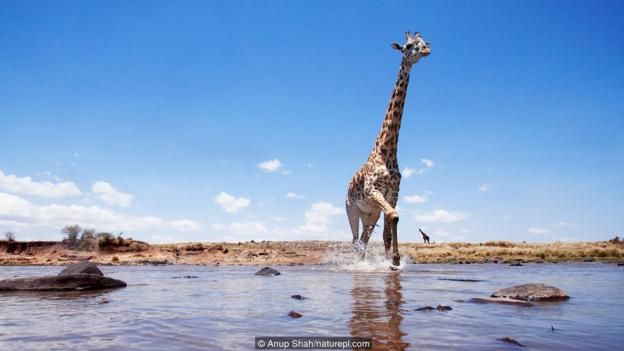The giraffe is the tallest land mammal alive, its long legs and neck contributing to its impressive stature. Males can be up to 18ft (5.5m tall), females a little less. In the wild, these beautiful creatures stretch their necks beyond those of antelope, kudu and even elephants to strip leaves from the untouched upper reaches of trees.
This has birthed a popular misconception: that long necks have evolved in giraffes because they allow them to get to the parts other herbivores cannot reach.
The French zoologist Jean-Baptiste Lamarck is usually credited as the first person to suggest this. As the giraffe lives "in places where the soil is nearly always arid and barren, it is obliged to browse on the leaves of trees and to make constant efforts to reach them," he wrote in his 1809 book Philosophie Zoologique. "From this habit long maintained in all its race, it has resulted that the animal's fore-legs have become longer than its hind legs, and that its neck is lengthened." In short, giraffes' long necks are the result of generation upon generation of repeated stretching and inheritance.
The English naturalist Charles Darwin also thought the giraffe's extraordinary legs and neck must have something to do with foraging. "The giraffe, by its lofty stature, much elongated neck, fore-legs, head and tongue, has its whole frame beautifully adapted for browsing on the higher branches of trees," he wrote in On the Origin of Species in 1859.
But Darwin did not buy Lamarck's ideas on how evolutionary change came about. Instead he argued that the giraffe's neck results from repeated "natural selection". Long-necked giraffes were more likely to survive hard times than their short-necked rivals. It has since become clear that Darwin was largely correct about how evolution works, and that Lamarck got it wrong. So it is important to understand the difference between Lamarckian and Darwinian mechanisms of evolution. However, it is a real shame that the giraffe is used to illustrate the point.
For a start, Lamarck made only a single, passing mention of giraffes in all his many writings. Yet it is this we remember him for – rather than the prescience of his ideas on evolution, which hugely influenced Darwin, or the many other contributions he made.

Worse still, the frequent deployment of giraffes when explaining natural selection has insinuated a big zoological porky into the public consciousness: namely, the idea pushed by both Lamarck and Darwin that giraffes' long necks evolved to help them feed.
The evidence to support this idea is decidedly thin. In 1996, zoologists Robert Simmons and Lue Scheepers set out several challenges to what has become known as the "competing browsers" hypothesis. "During the dry season (when feeding competition should be most intense) giraffe generally feed from low shrubs, not tall trees," they wrote in The American Naturalist. What's more, giraffes feed most often and faster with their necks bent.
There was also the troublesome question of why giraffes have been around 6.5ft (2m) taller than any of their competition for over 1 million years. By any measure, that is overkill.
So Simmons and Scheepers proposed an alternative: long necks have been sexually selected. This idea has become known as the "necks-for-sex" hypothesis. The first piece of evidence is that there are significant differences between the sexes. For instance, the neck and head dimensions of males far outstrip those of females. This is a strong indication that sexual selection may be in play.
Male giraffes often fight for access to females, a ritual referred to as "necking". The rivals stand flank to flank, then start to whack each other with their heads. "The top or back of the well-armored skull is used as a club to strike the neck, chest, ribs, or legs of the opponent with a force capable of knocking a competitor off balance or unconscious," wrote Simmons and Scheepers.
In an extreme case, reported in the 1960s, one male punctured his opponent's neck just below the ear. The impact splintered a vertebra and a shard of bone entered the luckless giraffe's spinal column, killing him.
The largest males usually win these battles and do most of the breeding, says zoologist Anne Innis Dagg of the University of Waterloo in Ontario, Canada, who has been studying giraffes since the 1950s. "The other giraffes don't get much breeding opportunity."

There is also evidence that females are more receptive to advances from larger males. Dagg says this all suggests that the exaggerated neck of the giraffe may have less to do with feeding and more to do with sex. Finally, there is another misconception about giraffes that Dagg is keen to set straight: the idea that there are plenty of them and we do not need to be concerned for their conservation. "Giraffes are now in danger of becoming extinct in the wild in some races," she says.
There are nine difference subspecies of giraffe. Two of them – the West African giraffe (Giraffa camelopardalis peralta) and Rothschild's giraffe (G. camelopardalis rothschildi) – are currently considered "endangered" on the IUCN's Red List of Threatened Species.
Several other subspecies may soon be added to the Red List, says Dagg. "Some are presently under serious consideration."
BBC










